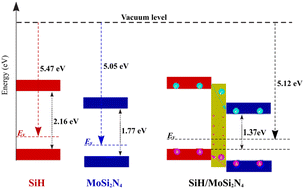Tunability of the electronic properties and contact types of the silicane/MoSi2N4 heterostructure under an electric field
Abstract
Stacking different two-dimensional materials to generate a vertical heterostructure has been considered a promising way to obtain the desired properties and to improve the device performance. Herein, we design a heterostructure composed between SiH and MoSi2N4 materials and investigate systematically the electronic properties and the formation of the contact types in the SiH/MoSi2N4 heterostructure using first-principles prediction. The results show that the SiH/MoSi2N4 heterostructure is structurally and mechanically stable and forms type-II band alignment because the VBM and CBM are located in different layers. The type-II SiH/MoSi2N4 heterostructure has an indirect band gap of 1.37 eV, which is ideal for the best light absorption characteristics. Moreover the electronic properties and band alignment of the SiH/MoSi2N4 heterostructure can be modified by applying an electric field. The negative electric field only leads to the reduction in the band gap, while the positive electric field not only gives rise to the increase in the band gap, but also leads to the transformation between type-II and type-I band alignment. Our findings broaden the way for the use of the SiH/MoSi2N4 heterostructure in high-performance electronic and photocatalytic applications.



 Please wait while we load your content...
Please wait while we load your content...